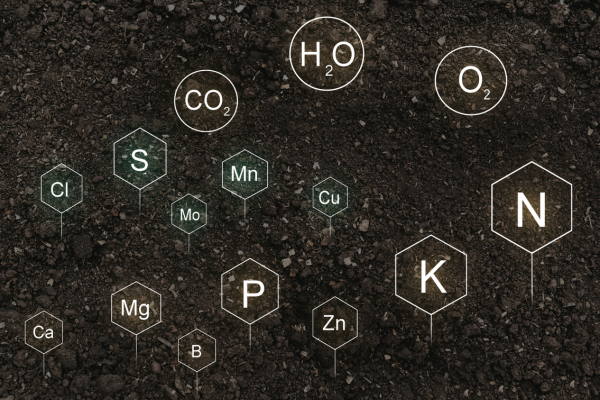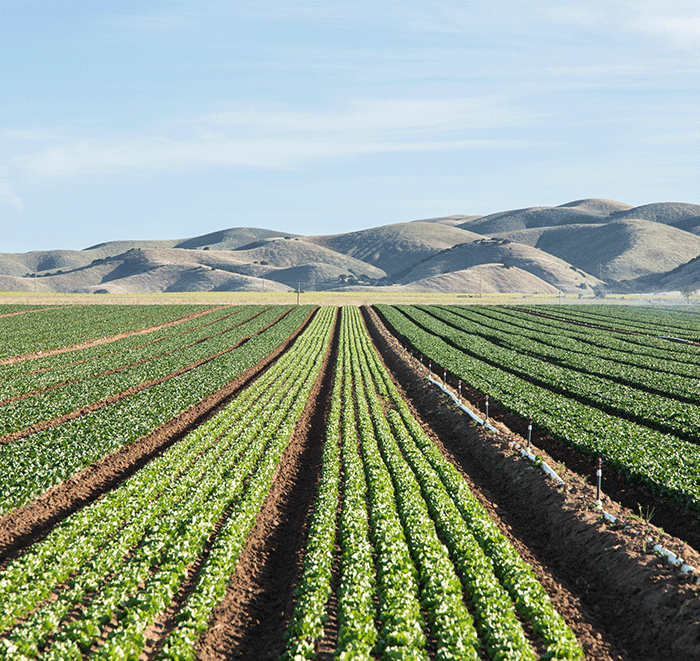
Soil Nutrients and Uptake
SOIL NUTRIENT SOURCES
In soil, water is held between the soil particles. This water, known as the soil solution, contains the dissolved cationic and anionic forms of soil nutrients. Nutrients in the soil solution are available for plant uptake. Cations in the soil solution may be attracted to and bound to negatively charged sites (cation exchange sites) on clay minerals and organic matter. Because cations are bound, they are not as readily leached from the soil. Cations held on the soil particles (colloids) are not directly available for plant uptake. For a bound cation to become available for plant uptake, it must be exchanged with another cation in the soil solution. In addition to providing cation exchange sites, soil organic matter (SOM) is a source of nitrogen, sulfur, boron, and phosphorus. These nutrients are released into the soil solution as SOM slowly decomposes. Soil minerals are the primary sources of phosphorous, potassium, and micronutrients needed by plants.
Soils do not have an infinite nutrient-holding capacity. Nutrients not bound to cation exchange sites, tied up in soil organic matter, or present as minerals can leach and “run-off” contaminating surface and groundwater. Soil pH affects the cation exchange capacity (CEC) of the soil and nutrient availability. Increasing soil pH increases cation exchange capacity and the soil’s cationic nutrient holding capacity. In general, increasing soil pH by one unit increases CEC by approximately 12%. Sand and silt particles do not have cation exchange sites and do not bind nutrients. Soils with lower clay content, and higher sand content have a lower nutrient holding capacity and greater potential for nutrient leaching.
Mechanisms of nutrient uptake
Mechanisms of nutrient uptake by plants include mass flow, diffusion, and root interception. In mass flow, nutrients simply flow into the plant root as the roots take up water. The dissolved nutrients in the soil solution essentially “hitchhike” among the water molecules. Nutrient movement via diffusion is based on a differential in nutrient concentration between the root and the surrounding soil solution. A lower concentration of nutrient ions in or near the root causes nutrient ions to move into the root. Nutrient uptake by root interception occurs when the root touches the soil particle and the ions are taken up by coming in contact with the root. This mechanism is particularly important in the uptake of nutrients that are tightly bound by the soil particles, such as phosphorus.
Cation Exchange Capacity
CEC of a soil is a function of the amount and type of clay particles in the soil, the amount of organic matter, and soil pH. Organic matter (OM) has a CEC of approximately 200 meq/100g, while clays range from 10 to 150 meq/100 g. CEC can be estimated from OM and clay content. If a soil contains 2.5% organic matter and 25% Montmorillonite clay (est. CEC = 100 meq/100 g) the soil would have an estimated CEC of 30 meq/100 g. (0.025 x 200 + 0.25 x 100).
The pH of the soil will affect the cation exchange capacity. As pH increases, CEC increases. Nine of the 16 essential plant nutrients exist in the soil solution as positively charged ions or cations (H, Ca, Mg, K, Fe, MN, Zn, Cu, and NH4). These cations are bound to cation exchange sites (negatively charged sites) on clay particles and soil organic matter. Other cations in the soil solution can be bound to these sites including some pesticides and other metals such as mercury and chromium. These bound cations serve as a reservoir for plant nutrients, replacing cations in the soil solution as they are absorbed by the plants. Cation exchange capacity (CEC) is a measure of soil fertility. CEC depends on the kind and quantity of clay in the soil, the amount of soil organic matter, and the soil pH. It is desirable, but not necessary, to have a high CEC to raise a high-yielding crop.
Dr. John McNamara // Wilbur-Ellis Agronomist


